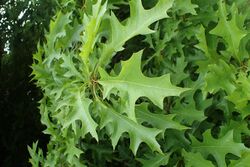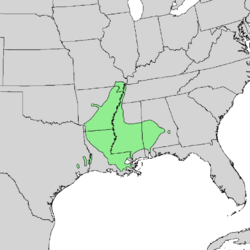Biology:Quercus texana
| Quercus texana | |
|---|---|

| |
| Scientific classification | |
| Kingdom: | Plantae |
| Clade: | Tracheophytes |
| Clade: | Angiosperms |
| Clade: | Eudicots |
| Clade: | Rosids |
| Order: | Fagales |
| Family: | Fagaceae |
| Genus: | Quercus |
| Subgenus: | Quercus subg. Quercus |
| Section: | Quercus sect. Lobatae |
| Species: | Q. texana
|
| Binomial name | |
| Quercus texana Buckley
| |

| |
| Natural range of Quercus texana | |
| Synonyms[2] | |
|
List
| |
Quercus texana, commonly known as Nuttall's oak,[3][4][5][6] is a fast-growing, large deciduous oak tree.
It is a tree growing up to 85 feet (25 meters) tall, with dark brown bark. It has leaves with sharp pointed lobes somewhat similar to those of the Georgia oak (Q. georgiana) and pin oak (Q. palustris).[7] It is fast-growing and usually has a pleasing red color in autumn, much more reliably so than the pin oak.
This species was for years erroneously called Quercus nuttallii, but it is now known as Q. texana; this has created much confusion with Texas red oak, which was known as Q. texana but is now known as Q. buckleyi.[8]
It is native to the south-central United States primarily in the lower Mississippi River Valley in Louisiana, Arkansas, Mississippi, Alabama, and western Tennessee . There are additional populations in eastern Texas , southeastern Oklahoma, southeastern Missouri, far western Kentucky, and the southernmost tip of Illinois.[9]
It is still relatively obscure in the horticultural industry but is slowly gaining popularity due to its fast growth rate, ease of transplanting, good fall colors and ability to grow in wet soils. It is known for its ability to rapidly recover its gas exchange after flooding.[10]
References
- ↑ Wenzell, K.; Kenny, L.; Jerome, D. (2017). "Quercus texana". IUCN Red List of Threatened Species 2017: e.T194239A111265845. doi:10.2305/IUCN.UK.2017-2.RLTS.T194239A111265845.en. https://www.iucnredlist.org/species/194239/111265845. Retrieved 12 November 2021.
- ↑ "Quercus texana Buckley". World Checklist of Selected Plant Families (WCSP). Royal Botanic Gardens (Kew). http://www.theplantlist.org/tpl1.1/record/kew-175464.
- ↑ "Oaks list for The State Botanical Garden of Kentucky" (English). http://www.ca.uky.edu/arboretum/brochures/Oaks.pdf.
- ↑ "J.C. Raulston slide 102-0276" (English). http://www.ncsu.edu/jcraulstonarboretum/photography/raulston_slides/raulston_slides_results.php?pageNum_slides_recordset=7&fullsearch=&box=&slide=&date=November%201989&photographer=&country=&usstate=&city=&location=&keywords=&othernotes=&plantnames=&commonnames=&families=&digitized=&plantnameID=.
- ↑ "Missouri Department of Conservation Species Scientific Name Index" (English). http://mdc.mo.gov/areas/natareas/scientif.htm.
- ↑ "University of Illinois Extension; Critical Issues Forum, What is the Current Status of Oaks in Illinois?" (English). http://web.extension.illinois.edu/forestry/critical_issues/diversity_issue.html.
- ↑ Nixon, Kevin C. (1997), "Quercus texana", in Flora of North America Editorial Committee, Flora of North America North of Mexico (FNA), 3, New York and Oxford, http://www.efloras.org/florataxon.aspx?flora_id=1&taxon_id=233501089
- ↑ Laurence J. Dorr and Kevin C. Nixon. 1985. Typification of the Oak (Quercus) Taxa Described by S. B. Buckley (1809-1884). Taxon 34(2): 211-228.
- ↑ "Quercus texana", County-level distribution map from the North American Plant Atlas (NAPA) (Biota of North America Program (BONAP)), 2014, http://bonap.net/MapGallery/County/Quercus%20texana.png
- ↑ Anderson, PH; Pezeshki, SR (1999). "The effects of intermittent flooding on seedlings of three forest species". Photosynthetica 37 (4): 543–552. doi:10.1023/A:1007163206642.
External links
- Nuttall's Oak in the Biosurvey of Oklahoma
- photo of herbarium specimen at Missouri Botanical Garden, collected in Missouri in 1989
Wikidata ☰ Q7271351 entry
 |



